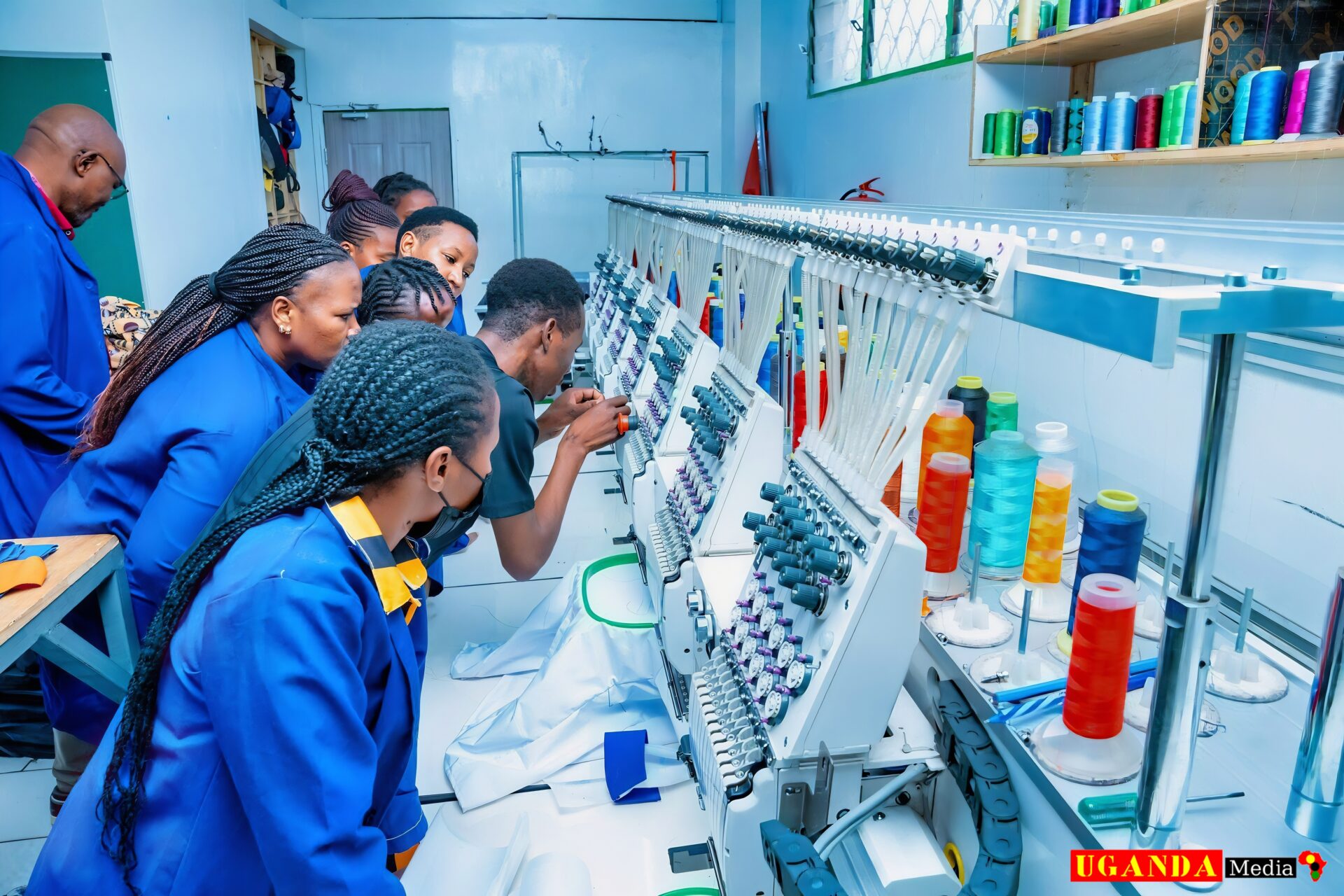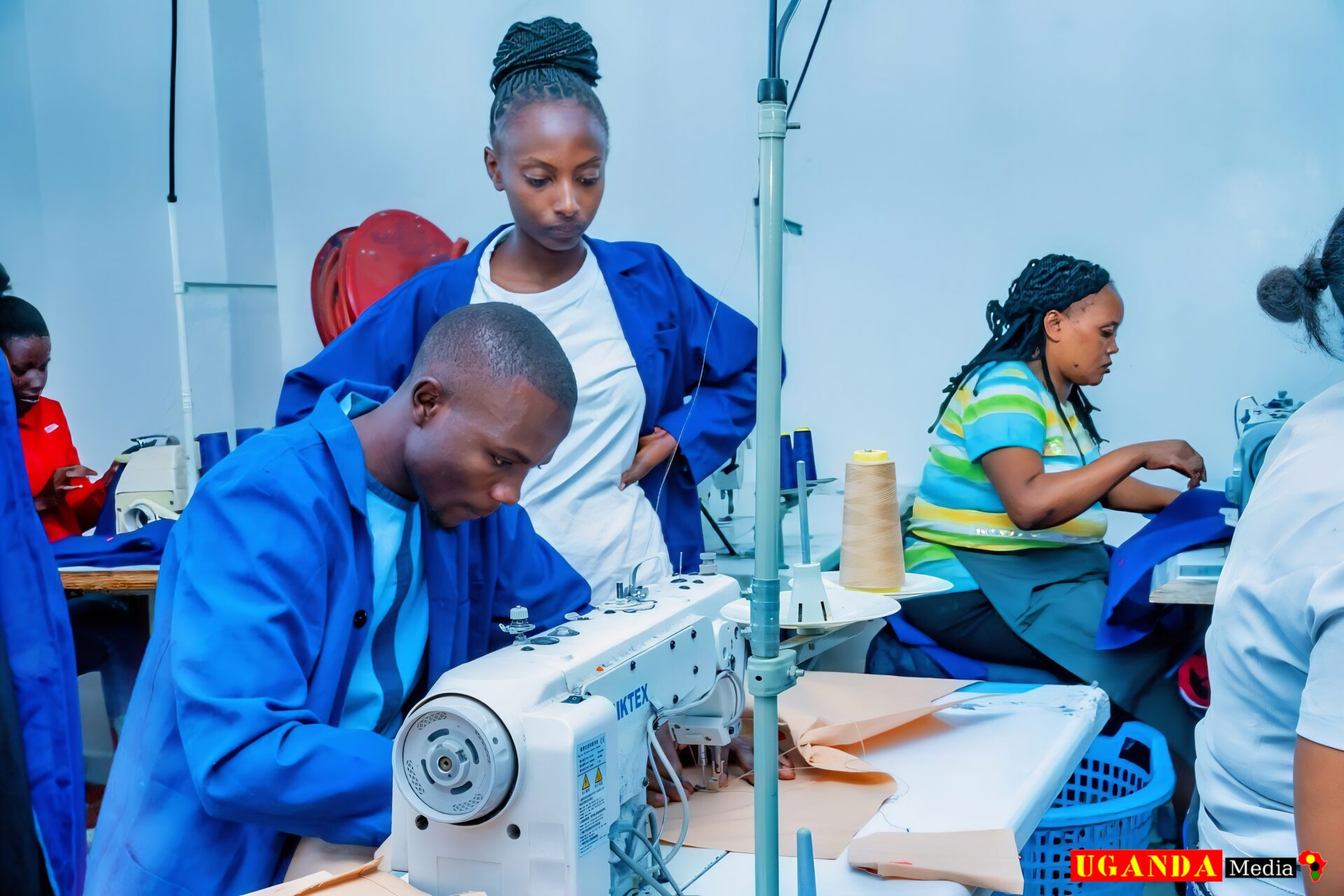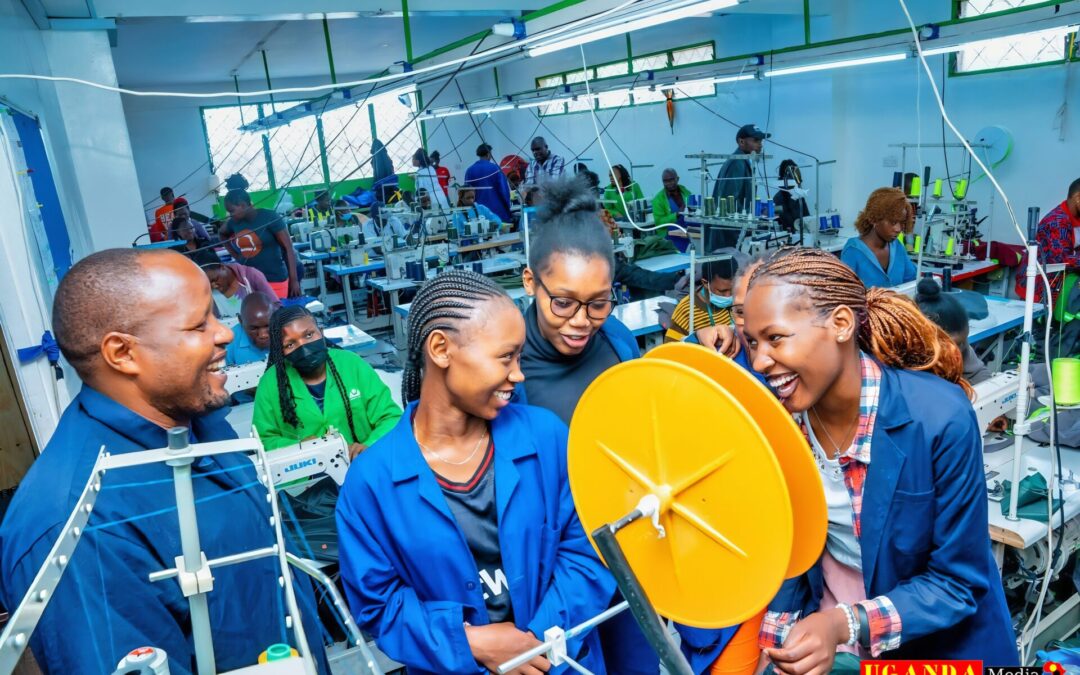Uganda Economic Update: Unlocking Growth Through Education, Agriculture, and Infrastructure
In the heart of East Africa, where fertile lands meet bustling markets and vibrant communities, lies Uganda—a nation brimming with potential. Known as the “Pearl of Africa,” this country has long been celebrated for its natural beauty, rich cultural heritage, and youthful population. Yet beneath the surface of optimism lies a complex economic landscape shaped by opportunities and obstacles alike. Enter the Uganda Economic Update (UEU), a bi-annual report published by the World Bank that serves as both a mirror reflecting the state of the economy and a compass guiding policymakers toward sustainable growth. In an era defined by rapid change and uncertainty, understanding the UEU’s insights is not just important—it’s essential.

This article delves into the latest findings from the UEU, exploring how Uganda can harness its strengths while addressing pressing challenges. From agriculture to education, investment to infrastructure, we’ll uncover the forces shaping Uganda’s future. Along the way, we’ll consider alternative perspectives and offer actionable steps for progress. By the end, you’ll have a clearer picture of what it will take to transform Uganda’s promise into prosperity.
Key Points to Explore
A Resilient Economy Amid Global Uncertainty
In a world grappling with the aftershocks of a global pandemic, rising inflation, and geopolitical tensions, Uganda stands as a testament to resilience. Despite these formidable challenges, the nation’s economy has shown an impressive ability to adapt and thrive. According to the Uganda Economic Update (UEU) , the country achieved a robust GDP growth rate of 6.4% in FY2022/23 , outpacing many of its regional peers. This performance is particularly commendable given the broader economic turbulence afflicting much of Africa and the world.
Drivers of Growth: Public Investments and Agriculture
The backbone of this growth lies in strategic public investments, particularly in the energy and oil sectors. The construction of large-scale infrastructure projects, such as hydropower dams and the long-awaited East African Crude Oil Pipeline, has injected vitality into the economy. These initiatives not only create jobs but also position Uganda as a potential energy hub for the region. Additionally, the agricultural sector—often referred to as the “heartbeat” of Uganda’s economy—has played a pivotal role. Improved weather conditions during the past year led to bountiful harvests, boosting both rural incomes and export revenues. Cash crops like coffee and tea continue to be vital earners of foreign exchange, underscoring the importance of agriculture in sustaining livelihoods.
However, beneath the surface of these achievements lies a sobering reality. While GDP growth paints a picture of progress, per capita income growth remains sluggish due to Uganda’s rapidly expanding population—one of the fastest-growing in the world. With an estimated annual population growth rate of 3% , the benefits of economic expansion are diluted when distributed across an ever-increasing number of people. This raises critical questions about whether the current trajectory of growth is truly inclusive or merely superficial.
The Inequality Debate: Is Growth Truly Shared?
Critics argue that Uganda’s economic model risks exacerbating inequality rather than alleviating poverty. For instance, while urban areas have seen significant infrastructural development, rural communities—home to over 75% of Ugandans—continue to grapple with inadequate access to basic services such as electricity, clean water, and quality education. A farmer in northern Uganda may witness bumper harvests, but without proper storage facilities or reliable transport networks, their produce often spoils before reaching markets. Similarly, young graduates entering the workforce face limited opportunities despite the government’s emphasis on industrialisation and job creation.
This disparity is not unique to Uganda; it echoes a broader trend across Sub-Saharan Africa, where rapid economic growth has frequently failed to translate into meaningful improvements in living standards for the majority. In neighbouring Kenya, for example, Nairobi’s skyline gleams with modern skyscrapers, yet informal settlements like Kibera remain mired in poverty. The lesson here is clear: growth must be deliberately structured to uplift the most vulnerable segments of society, lest it deepen existing divides.
Lessons from Africa’s Success Stories
To address these concerns, Uganda could draw inspiration from other African nations that have successfully balanced growth with inclusivity. Tanzania, for instance, has prioritised universal healthcare and digital transformation, ensuring that even remote communities benefit from national progress. Ethiopia’s focus on industrial parks has created thousands of manufacturing jobs, particularly for women. By adopting similar strategies tailored to its context, Uganda can ensure that its economic gains reach beyond urban elites and multinational corporations.
The Role of Governance and Policy
At the heart of this debate lies governance. Transparent and accountable institutions are crucial to translating macroeconomic success into tangible benefits for ordinary citizens. Corruption, bureaucratic inefficiencies, and weak enforcement of regulations remain persistent hurdles. Without addressing these systemic issues, even the most ambitious policies risk falling short. For example, funds earmarked for rural electrification projects sometimes vanish into thin air, leaving villages still reliant on kerosene lamps. Strengthening oversight mechanisms and fostering civic engagement will be essential to building trust and ensuring equitable distribution of resources.
Looking Ahead: Balancing Growth with Equity
As Uganda navigates the complexities of global uncertainty, the challenge ahead is twofold: sustaining economic momentum while ensuring that no one is left behind. Policymakers must strike a delicate balance between attracting foreign investment and safeguarding local interests. They must also recognise that true prosperity cannot be measured solely by GDP figures—it must be reflected in healthier children, empowered women, and thriving communities.

In conclusion, Uganda’s resilience amidst global headwinds is commendable, but it is only the beginning of a longer journey. The nation’s leaders must ask themselves whether they are content with being a poster child for GDP growth or if they aspire to become a beacon of inclusive development. The answer to this question will shape not just Uganda’s future, but its legacy as a leader in Africa’s quest for sustainable and equitable progress.
The Backbone of Agriculture: Opportunities and Vulnerabilities
In Uganda, agriculture is not just a sector—it is the lifeblood of the nation. With 70% of Ugandans depending on farming for their livelihoods, the agricultural sector is the cornerstone of the economy, contributing significantly to GDP, employment, and export earnings. From the fertile fields of the central region to the lush highlands of the southwest, agriculture sustains millions of households and fuels local markets. Yet, this vital sector faces profound vulnerabilities that threaten its long-term viability in an era of climate uncertainty and rapid population growth.
Opportunities: A Sector Rich with Potential
Uganda’s agricultural potential is immense. Blessed with fertile soils, abundant rainfall (in most regions), and a diverse range of crops—from coffee and tea to maize and cassava—the country is uniquely positioned to become a regional food basket and a global player in agribusiness. Recent years have seen promising developments, particularly due to favourable weather conditions that have boosted harvests. For instance, bumper yields of key crops like maize and beans have not only improved rural incomes but also enhanced food security at a time when many African nations face shortages.
Moreover, Uganda’s youthful population presents an opportunity to modernise agriculture through innovation. Young entrepreneurs are increasingly turning to agri-tech solutions, such as mobile apps that connect farmers to markets, drones for crop monitoring, and precision farming techniques. These innovations have the potential to revolutionise productivity, reduce post-harvest losses, and make farming more profitable. For example, initiatives like the National Agricultural Advisory Services (NAADS) programme aim to equip smallholder farmers with better seeds, fertilisers, and training, empowering them to increase yields and incomes.
However, despite these opportunities, the sector remains constrained by systemic challenges that hinder its full potential.
Vulnerabilities: The Fragility of Rain-Fed Farming
One of the most glaring vulnerabilities of Ugandan agriculture is its heavy reliance on rain-fed farming. Over 90% of the country’s farmland depends on rainfall , leaving it highly susceptible to climate shocks. In recent years, erratic weather patterns—exacerbated by climate change—have wreaked havoc on farming communities. Prolonged droughts in northern Uganda, for instance, have devastated crops and livestock, pushing families deeper into poverty. Similarly, unpredictable flooding in low-lying areas has destroyed harvests, leaving farmers struggling to recover.
Consider the plight of a farmer in Karamoja, a semi-arid region in northeastern Uganda. Here, prolonged dry spells have forced many households to rely on food aid, as traditional crops fail to thrive. Even in more fertile regions like the central and western parts of the country, unseasonal rains or prolonged dry periods can disrupt planting cycles, leading to reduced yields and income instability. This dependence on unpredictable weather underscores the urgent need for irrigation systems and climate-smart practices.
The Case for Irrigation and Climate-Smart Solutions
Investing in irrigation infrastructure could transform Ugandan agriculture by reducing its vulnerability to climate variability. Currently, less than 5% of arable land is irrigated, a stark contrast to countries like Israel or Egypt, where irrigation has turned deserts into productive farmland. By expanding access to affordable irrigation technologies, such as solar-powered pumps and drip irrigation systems, Uganda could ensure year-round farming, boost productivity, and enhance resilience to droughts.
Climate-smart practices also hold great promise. Techniques like conservation agriculture—where farmers minimise soil disturbance, maintain soil cover, and rotate crops—can improve yields while preserving natural resources. Agroforestry, which integrates trees into farmland, offers another sustainable solution, providing shade, improving soil fertility, and sequestering carbon. These approaches align with Uganda’s commitment to combating climate change under international frameworks like the Paris Agreement.
Funding Gaps: Bridging the Divide
Despite the clear benefits of modernising agriculture, funding remains a major obstacle. Many smallholder farmers lack access to affordable credit, making it difficult to invest in improved seeds, fertilisers, or irrigation equipment. Government programmes, though well-intentioned, often suffer from inefficiencies and corruption, with funds failing to reach those who need them most. For instance, delays in disbursing subsidies under the NAADS programme have left many farmers disillusioned.
International partners, including the World Bank and the African Development Bank, have stepped in to support agricultural development. However, these efforts must be complemented by stronger domestic resource mobilisation. Increasing the national budget allocation to agriculture—from its current 3-4% to the recommended 10% under the Maputo Declaration—could provide much-needed resources to address infrastructure gaps and promote innovation.
Real-World Examples: Lessons from Within and Beyond
Uganda can draw inspiration from successful agricultural transformations both within Africa and globally. In Ethiopia, the government’s investment in large-scale irrigation projects has transformed previously barren lands into thriving agricultural hubs. Closer to home, Kenya’s adoption of digital platforms like Twiga Foods has streamlined supply chains, connecting farmers directly to urban markets and reducing post-harvest losses. Such examples demonstrate that with the right mix of policy support, technological innovation, and community engagement, agriculture can drive inclusive growth.
A Call to Action: Securing the Future of Ugandan Agriculture
To secure the future of its agricultural sector, Uganda must adopt a dual approach: addressing immediate vulnerabilities while laying the groundwork for long-term transformation. Short-term measures, such as scaling up drought-resistant crops and expanding social safety nets for vulnerable farmers, can cushion communities against climate shocks. At the same time, strategic investments in irrigation, agri-tech, and value addition can position Uganda as a leader in sustainable agriculture.
Ultimately, agriculture is not just about feeding a growing population—it is about building a resilient economy that can withstand global uncertainties. As Uganda charts its path forward, the question remains: will it seize the opportunity to transform its agricultural backbone into a pillar of prosperity? The answer lies in the hands of policymakers, farmers, and innovators alike. For a nation so deeply rooted in the land, the stakes could not be higher.
Education: The Key to Unlocking Human Potential
In the quest for sustainable development, few investments hold as much transformative power as education. The latest Uganda Economic Update (UEU) places education at the forefront of its recommendations, underscoring its pivotal role in shaping Uganda’s future. Yet, despite its importance, the state of education in Uganda paints a sobering picture. With students achieving only 4.5 years of effective learning by the time they reach age 18—far below the Sub-Saharan African average of 8.1 years —the country is failing to unlock the full potential of its most valuable resource: its people.
The Learning Crisis: A Nation at Risk
The phrase “effective learning” is critical here. While many Ugandan children attend school, the quality of education they receive is alarmingly low. Poorly trained teachers, overcrowded classrooms, and outdated curricula have resulted in what experts call a “learning crisis.” For every year spent in school, students gain less than half the expected knowledge and skills. This gap is particularly acute in rural areas, where schools often lack basic infrastructure such as electricity, clean water, and textbooks.
Imagine a child in northern Uganda who walks miles to attend a dilapidated classroom with no desks or teaching materials. Despite their determination, they leave school ill-prepared to compete in a rapidly changing job market. This wasted potential not only stifles individual aspirations but also hampers national productivity. A workforce unable to innovate or adapt will struggle to drive economic growth, leaving Uganda trailing behind its regional peers.
The Cost of Inaction: Stagnation and Inequality
The consequences of neglecting education extend far beyond the classroom. Without meaningful reforms, Uganda risks perpetuating cycles of poverty and inequality. Education is one of the strongest predictors of future earnings; each additional year of schooling increases an individual’s income by approximately 11-14% . By failing to provide quality education, Uganda limits its citizens’ ability to break free from poverty and contribute meaningfully to the economy.
Moreover, the gender disparity in educational outcomes exacerbates social inequities. Girls, in particular, face barriers such as early marriage, cultural biases, and inadequate sanitation facilities in schools. When girls are denied access to education, entire communities suffer. Studies show that educated women are more likely to invest in their children’s health and education, creating a ripple effect that benefits generations to come.
A Roadmap for Reform: Prioritising Teacher Training, Curriculum Reform, and Financing
To address these challenges, the UEU calls for bold action across three key areas: teacher training, curriculum reform, and increased financing.
- Teacher Training : Teachers are the backbone of any education system, yet many in Uganda lack the necessary skills and support. Providing ongoing professional development and equipping teachers with modern pedagogical tools can significantly improve classroom outcomes. For example, initiatives like the Global Partnership for Education have shown how targeted training programmes can enhance teaching quality and student performance.
- Curriculum Reform : Uganda’s education system must evolve to meet the demands of the 21st century. This means moving away from rote memorisation and towards critical thinking, problem-solving, and digital literacy. Introducing practical subjects like entrepreneurship and vocational skills could better prepare students for the labour market. Rwanda’s success in integrating STEM (Science, Technology, Engineering, and Mathematics) into its curriculum offers a model worth emulating.
- Increased Financing : Perhaps the most contentious recommendation is the call to allocate 16% of the national budget to education—a benchmark aligned with Sub-Saharan African averages. Currently, Uganda spends just 10% , leaving schools underfunded and overburdened. Sceptics argue that increasing spending on education may strain public finances, especially given competing priorities like healthcare and infrastructure. However, the long-term dividends are undeniable. Higher educational attainment leads to reduced poverty, improved health outcomes, and enhanced economic competitiveness—all vital for Uganda’s transition to middle-income status.
Addressing Counterarguments: Is It Worth the Investment?
Critics may question the feasibility of allocating 16% of the budget to education, citing fiscal constraints and inefficiencies in public spending. Indeed, past efforts to boost education funding have sometimes been undermined by corruption and mismanagement. For instance, scandals involving the misappropriation of funds meant for Universal Primary Education (UPE) have eroded public trust.
However, these challenges should not deter action—they should inspire reform. Strengthening accountability mechanisms, improving transparency, and engaging communities in decision-making can help ensure that resources are used effectively. Moreover, investing in education is not merely an expense; it is an investment with measurable returns. According to the World Bank, every dollar invested in education generates up to $10 in economic benefits . For a nation like Uganda, where two-thirds of the population is under 30, prioritising education is not optional—it is imperative.
Real-World Examples: Lessons from Within and Beyond
Uganda can learn valuable lessons from countries that have successfully transformed their education systems. Kenya, for example, has made significant strides in improving access and quality through initiatives like the Digital Literacy Programme , which provides tablets to primary school students. Closer to home, Uganda’s own MasterCard Foundation Scholars Program has empowered thousands of disadvantaged youth with scholarships and mentorship opportunities, demonstrating the impact of targeted interventions.
On a global scale, Finland’s education system serves as a beacon of excellence. By focusing on teacher professionalism, equity, and learner-centred approaches, Finland consistently ranks among the top performers in international assessments. While replicating Finland’s model wholesale may not be feasible, adopting elements of its philosophy could yield substantial improvements in Uganda.
A Vision for the Future: Building a Knowledge Economy
As Uganda strives to achieve its vision of becoming a middle-income country by 2040, education must take centre stage. A well-educated populace is the foundation of a knowledge-based economy, capable of driving innovation, attracting foreign investment, and fostering sustainable development. But realising this vision requires more than rhetoric—it demands commitment, collaboration, and courage.
The stakes are high, but so too is the reward. By investing in education today, Uganda can equip its youth with the skills and knowledge needed to thrive tomorrow. Imagine a generation of Ugandans who are not just consumers of technology but creators of it; who are not just job seekers but job creators. Such a future is within reach—if we choose to seize it.
In conclusion, education is not merely a policy issue; it is a moral imperative. For a nation blessed with abundant natural resources and a youthful population, failing to prioritise education would be tantamount to squandering its greatest asset. As the UEU makes clear, the path to prosperity begins in the classroom. Will Uganda rise to the challenge? The answer lies in the choices we make today—for our children, our communities, and our collective future.
Infrastructure Development: Building Foundations for Growth
In the race to transform Uganda into a thriving middle-income nation, infrastructure development stands as a cornerstone of progress. From constructing modern road networks to developing energy projects that light up homes and power industries, these initiatives are designed to lay the groundwork for sustained economic growth. However, while ambitious projects like the Standard Gauge Railway (SGR) and oil refineries hold immense promise, they also come with significant risks—chief among them delays, cost overruns, and the spectre of unsustainable debt. For Uganda, the challenge lies in balancing ambition with accountability, ensuring that these megaprojects deliver tangible benefits without jeopardising the nation’s financial stability.
The Promise of Infrastructure: A Catalyst for Economic Transformation
Infrastructure is often described as the “backbone” of economic development—and for good reason. Efficient transportation systems reduce the cost of moving goods, reliable electricity attracts investors, and improved communication networks connect businesses to global markets. In Uganda, where much of the population resides in rural areas, infrastructure development has the potential to bridge divides, unlock opportunities, and integrate communities into the broader economy.
Consider the impact of the ongoing construction of the SGR, which aims to link Kampala to key regional hubs like Mombasa in Kenya and Kigali in Rwanda. Once completed, this railway will slash freight costs, expedite trade, and position Uganda as a logistical gateway for East Africa. Similarly, the anticipated launch of oil production in the Albertine Graben region promises to generate billions in revenue, create jobs, and fund further infrastructure projects such as roads, hospitals, and schools.
Energy projects, too, are central to Uganda’s vision. The Karuma and Isimba hydropower dams, once fully operational, are expected to double the country’s electricity generation capacity, providing affordable and reliable power to households and industries alike. Such developments could spur industrialisation, attract foreign direct investment (FDI), and diversify Uganda’s economy beyond its reliance on agriculture.
The Challenges: Delays, Cost Overruns, and Debt Concerns
Despite their potential, many of these projects have faced significant hurdles. Delays are commonplace, with timelines stretching far beyond initial projections. For instance, the SGR project, first announced over a decade ago, has encountered repeated setbacks due to funding gaps, bureaucratic bottlenecks, and disagreements between stakeholders. These delays not only inflate costs but also delay the economic benefits that the infrastructure is meant to deliver.
Cost overruns have been another persistent issue. Large-scale projects often exceed their original budgets, placing additional strain on public finances. Take, for example, the Bujagali Hydropower Plant, which ended up costing nearly twice its initial estimate. While such projects eventually contribute to economic growth, the financial burden they impose can be substantial, particularly when loans from international financiers come with high-interest rates or stringent repayment terms.
Perhaps the most pressing concern is the risk of unsustainable debt. Uganda, like many African nations, has increasingly turned to external borrowing to finance its infrastructure ambitions. According to the World Bank, Uganda’s public debt-to-GDP ratio has risen steadily in recent years, raising alarms about the country’s ability to service its obligations. Critics warn that unless carefully managed, this debt could spiral out of control, undermining the very growth it seeks to stimulate.
Balancing Ambition with Accountability
To ensure that infrastructure projects yield maximum returns, Uganda must adopt a more disciplined approach to planning and execution. Here are three critical steps:
- Improved Project Management : Strengthening institutional capacity is essential to avoid delays and cost overruns. This includes hiring skilled project managers, streamlining approval processes, and fostering greater collaboration between government agencies and private sector partners. Learning from countries like Ethiopia, which has successfully implemented large-scale infrastructure projects through meticulous planning, could prove invaluable.
- Transparent Financing Mechanisms : Greater transparency in how funds are allocated and spent is crucial to building public trust and preventing corruption. Establishing independent oversight bodies to monitor project implementation and audit expenditures would help curb misuse of resources. For example, the controversy surrounding the Entebbe-Kampala Expressway—a project marred by allegations of inflated contracts—highlights the need for stricter accountability measures.
- Prioritising Sustainable Debt Levels : Borrowing for infrastructure is justified if the resulting assets generate sufficient economic returns to repay the debt. However, Uganda must exercise caution to avoid over-leveraging itself. Exploring alternative financing models, such as public-private partnerships (PPPs) or blended finance arrangements, could reduce reliance on expensive loans. Additionally, prioritising projects with clear economic viability—such as those directly tied to boosting exports or creating jobs—can maximise the return on investment.
Addressing Counterarguments: Are Megaprojects Worth the Risk?
Sceptics may argue that Uganda should focus on smaller, community-level projects rather than pouring resources into costly megaprojects. After all, repairing rural roads or expanding access to clean water might offer more immediate benefits to ordinary citizens than a multi-billion-dollar railway line. While this perspective has merit, it overlooks the transformative potential of strategic infrastructure investments. For example, the expansion of airports in Entebbe and Arua is already attracting tourists and boosting local economies, demonstrating how large-scale projects can catalyse broader development.
That said, critics rightly point out that poorly executed megaprojects can do more harm than good. The case of Tanzania’s Standard Gauge Railway, which has faced similar challenges to Uganda’s, serves as a cautionary tale. Without proper oversight and fiscal discipline, even the most well-intentioned projects can become white elephants, draining resources without delivering commensurate benefits.
Real-World Examples: Lessons from Within and Beyond
Uganda can draw inspiration from both regional successes and failures. In Rwanda, President Paul Kagame’s government has prioritised infrastructure as part of its Vision 2050 strategy. Investments in smart cities, fibre-optic networks, and renewable energy have positioned Rwanda as a leader in digital transformation across Africa. Closer to home, Kenya’s Lamu Port-South Sudan-Ethiopia Transport (LAPSSET) corridor offers insights into the complexities of executing cross-border infrastructure projects, including the importance of stakeholder coordination and long-term planning.
Globally, China’s Belt and Road Initiative provides mixed lessons. While some African countries have benefited from Chinese-funded infrastructure projects, others have fallen into debt traps due to opaque agreements and unsustainable loan terms. Uganda must tread carefully, ensuring that partnerships with foreign investors align with national interests and priorities.
A Call to Action: Building for the Future
Infrastructure development is not just about building roads, railways, or power plants—it is about laying the foundation for a brighter future. For Uganda, these projects represent an opportunity to leapfrog traditional stages of development, positioning the country as a competitive player in the global economy. But seizing this opportunity requires foresight, discipline, and a commitment to putting people first.
As policymakers weigh the costs and benefits of each project, they must ask themselves: Will this initiative improve lives? Will it strengthen our economy? And will it leave a legacy we can be proud of? The answers to these questions will determine whether Uganda’s infrastructure dreams become reality—or remain unfulfilled aspirations.
In conclusion, infrastructure is not merely a means to an end; it is a statement of intent. By investing wisely and responsibly, Uganda can build a nation that works—for everyone. The journey ahead may be fraught with challenges, but with determination and accountability, the Pearl of Africa can shine brighter than ever before.
Youth Employment: Harnessing Demographic Dividends
Uganda is a nation on the brink of transformation—or turmoil—depending on how it chooses to navigate its most defining characteristic: its youthful population. With over 75% of its citizens under the age of 30 , Uganda finds itself at a demographic crossroads. This youthful energy, if harnessed effectively, could propel the country into an era of unprecedented economic growth and innovation. However, failure to address the pressing issue of youth unemployment risks squandering this potential, leading to social unrest and economic stagnation. As the Uganda Economic Update (UEU) highlights, equipping young people with the skills and opportunities they need is not just a policy imperative—it is a moral obligation.
The Promise of Youth: A Double-Edged Sword
Uganda’s youthful population is both its greatest asset and its most daunting challenge. On one hand, a large working-age population presents a unique opportunity to reap the so-called “demographic dividend.” When young people are educated, skilled, and gainfully employed, they become engines of economic growth, driving productivity, innovation, and consumer spending. For instance, countries like South Korea and Singapore leveraged their youthful populations during periods of rapid industrialisation to achieve sustained prosperity.
On the other hand, Uganda’s youth bulge carries significant risks if left unaddressed. The UEU notes that unemployment rates among young Ugandans remain alarmingly high, particularly among university graduates. Many young people find themselves trapped in a cycle of underemployment, taking on informal or low-paying jobs that fail to utilise their qualifications. This mismatch between education and market demands leaves thousands of bright minds idle, frustrated, and disillusioned—a recipe for social instability.
Consider the story of Sarah, a recent graduate from Makerere University with a degree in business administration. Despite her academic achievements, Sarah struggles to find meaningful employment. Like many of her peers, she spends her days applying for jobs online, attending endless interviews, and competing against hundreds of equally qualified candidates for a handful of positions. Her story is far from unique; it reflects the reality faced by countless young Ugandans who feel abandoned by a system that promised them better futures.
The Skills Gap: Bridging Education and Employment
At the heart of Uganda’s youth employment crisis lies a fundamental disconnect between what young people learn in school and what employers need in the workplace. Traditional education systems often prioritise theoretical knowledge over practical skills, leaving graduates ill-prepared for the demands of modern industries. Vocational training programmes and entrepreneurship support initiatives offer a viable solution to bridge this gap.

- Vocational Training Programmes : Investing in technical and vocational education and training (TVET) can equip young people with hands-on skills that align with market demands. For example, courses in carpentry, plumbing, welding, and ICT can prepare students for lucrative careers in growing sectors such as construction, manufacturing, and technology. Successful models exist within Uganda, such as the Nakawa Vocational Training Institute , which has empowered thousands of youth with employable skills. Expanding access to similar programmes, especially in rural areas, could significantly reduce youth unemployment.
- Entrepreneurship Support : Encouraging entrepreneurship is another critical pathway to addressing youth unemployment. By providing mentorship, seed funding, and business development services, the government and private sector can help young innovators turn their ideas into thriving enterprises. Initiatives like the Youth Livelihood Programme (YLP) , which offers grants to youth-led startups, have already shown promise. Scaling up such efforts and fostering linkages with incubators and accelerators could unleash a wave of homegrown entrepreneurs.
Addressing Counterarguments: Is Focusing on Youth Enough?
Critics may argue that prioritising youth employment detracts attention from broader structural reforms needed to drive long-term economic growth. They contend that issues such as corruption, weak institutions, and inadequate infrastructure must take precedence over targeted interventions for young people. While these concerns are valid, neglecting youth employment risks exacerbating existing challenges. Unemployed youth are more susceptible to engaging in illicit activities, joining extremist groups, or participating in protests and riots—all of which destabilise society and hinder progress.
Moreover, investing in youth is not mutually exclusive from pursuing structural reforms. In fact, empowering young people can accelerate systemic change by creating a new generation of leaders, taxpayers, and consumers who contribute to national development. For example, a young entrepreneur running a successful agribusiness not only creates jobs but also stimulates demand for goods and services, boosting local economies.
Real-World Examples: Lessons from Within and Beyond
Uganda can draw valuable lessons from both regional successes and global best practices. In Rwanda, the government has made remarkable strides in reducing youth unemployment through initiatives like the Hanga Umurimo (“Create Jobs”) programme, which combines skills training with job placement services. Similarly, Kenya’s Ajira Digital Programme has equipped thousands of young people with digital skills, enabling them to access remote work opportunities in fields like graphic design, data entry, and software development.
Globally, Germany’s dual education system serves as a model worth emulating. This system integrates classroom learning with on-the-job training, ensuring that students graduate with practical experience and guaranteed pathways to employment. Adopting elements of this approach could revolutionise Uganda’s TVET landscape, making it more responsive to industry needs.
A Vision for the Future: Empowering Uganda’s Youth
To harness its demographic dividend, Uganda must adopt a holistic strategy that addresses both immediate and long-term challenges. Short-term measures, such as expanding access to apprenticeships, internships, and short-term skills programmes, can provide quick wins. At the same time, long-term investments in education reform, curriculum modernisation, and teacher training will ensure that future generations are better prepared for the workforce.
Public-private partnerships (PPPs) will play a crucial role in this effort. By collaborating with businesses, NGOs, and international organisations, the government can pool resources, share expertise, and scale impactful initiatives. For example, multinational corporations operating in Uganda could sponsor training programmes tailored to their specific hiring needs, creating a win-win scenario for employers and employees alike.
A Call to Action: The Time to Act is Now
The stakes could not be higher. Uganda’s youthful population represents a once-in-a-generation opportunity to transform the nation’s trajectory. But time is of the essence. If current trends persist, millions of young people will continue to languish in unemployment, losing faith in the promise of a better tomorrow.
As policymakers deliberate on the way forward, they must remember that youth employment is not just an economic issue—it is a social and political imperative. By investing in the next generation, Uganda can build a future where every young person has the chance to thrive, innovate, and contribute to the nation’s prosperity. The question is not whether Uganda can afford to act—but whether it can afford not to.
In conclusion, Uganda stands at a pivotal moment in its history. Its youth are its greatest hope—and its greatest challenge. By empowering them with the tools, opportunities, and platforms they need to succeed, the Pearl of Africa can unlock a brighter, more inclusive future for all. The choice is clear: harness the power of youth, or risk being left behind.
Regional Dynamics: Navigating Neighbourhood Tensions
Uganda’s economic and political fortunes are deeply intertwined with the dynamics of its neighbours in East Africa. As a landlocked nation, Uganda relies heavily on regional trade routes, cross-border cooperation, and diplomatic relationships to sustain its economy and ensure security. However, recent tensions with Rwanda, ongoing instability in South Sudan, and broader geopolitical challenges have cast a shadow over Uganda’s aspirations for regional integration. At the same time, opportunities such as the African Continental Free Trade Area (AfCFTA) present exciting prospects for export diversification and economic growth. Striking the right balance between diplomacy and economic pragmatism will be crucial as Uganda navigates these complex regional dynamics.
The Risks of Regional Tensions
Political tensions with Rwanda and security concerns in neighbouring countries like South Sudan and the Democratic Republic of Congo (DRC) pose significant risks to Uganda’s external stability. For instance, the strained relationship between Kampala and Kigali has led to border closures and disruptions in trade flows. The once-bustling Mutukula border, a key transit point for goods moving between Uganda and Rwanda, has seen reduced activity due to heightened restrictions and mutual distrust. This not only affects businesses that rely on cross-border trade but also undermines investor confidence in the region.
Similarly, instability in South Sudan—a major market for Ugandan exports—has disrupted supply chains and reduced demand for Ugandan goods. The conflict in eastern DRC, fuelled by militia activity and regional rivalries, further complicates Uganda’s efforts to maintain peaceful borders. These tensions highlight the precarious nature of Uganda’s geographic position, where peace and prosperity are contingent upon the stability of its neighbours.
For ordinary Ugandans, these regional challenges manifest in tangible ways. Farmers in western Uganda who rely on exporting maize and beans to Rwanda face losses when trade routes are blocked. Truck drivers transporting goods through volatile regions risk delays or even attacks, increasing operational costs and reducing competitiveness. Such disruptions underscore the need for proactive diplomacy and conflict resolution mechanisms.
Opportunities Through Regional Integration
Despite these challenges, Uganda stands to benefit immensely from deeper regional integration, particularly through initiatives like the African Continental Free Trade Area (AfCFTA) . Launched in 2021, AfCFTA aims to create the world’s largest free trade area, encompassing 54 African nations and a combined GDP of over $3 trillion. By dismantling tariff barriers and harmonising regulations, the agreement offers Uganda an unprecedented opportunity to diversify its exports beyond traditional commodities like coffee and tea.

Currently, Uganda’s export base is heavily reliant on a few primary products, leaving it vulnerable to global price fluctuations. AfCFTA provides a platform to tap into new markets for manufactured goods, processed foods, and services. For example, Ugandan agribusinesses could expand their reach across Africa by exporting value-added products such as roasted coffee, packaged juices, or fortified cereals. Similarly, Uganda’s burgeoning manufacturing sector—particularly textiles and construction materials—could find lucrative opportunities in neighbouring countries.
Moreover, regional integration fosters collaboration on critical infrastructure projects. The planned Central Corridor project, which seeks to link Dar es Salaam Port in Tanzania to landlocked countries like Uganda, Rwanda, and Burundi, exemplifies how shared infrastructure can enhance connectivity and reduce logistical costs. By positioning itself as a hub for trade and logistics within East Africa, Uganda can attract foreign investment and stimulate local industries.
Striking the Balance: Diplomacy Meets Economic Pragmatism
To maximise the benefits of regional integration while mitigating the risks posed by neighbourhood tensions, Uganda must adopt a dual approach rooted in diplomacy and economic pragmatism.
- Strengthening Diplomatic Engagement : Resolving disputes with Rwanda requires sustained dialogue and confidence-building measures. High-level summits under the auspices of the East African Community (EAC) offer a neutral platform for addressing grievances and rebuilding trust. Additionally, engaging civil society organisations and private sector stakeholders can foster grassroots reconciliation and promote people-to-people ties.
- Enhancing Border Security and Trade Facilitation : Investing in smart border technologies, such as electronic cargo tracking systems and single customs windows, can streamline trade processes and reduce friction at border crossings. Collaborating with international partners, such as the World Bank and USAID, can provide technical assistance and funding for these initiatives.
- Promoting Economic Interdependence : Deepening economic ties with neighbours can serve as a buffer against political tensions. Joint ventures in sectors like energy, agriculture, and tourism can create mutual dependencies that incentivise cooperation over confrontation. For instance, Uganda’s oil production in the Albertine Graben region presents opportunities for regional partnerships in refining and distribution.
Addressing Counterarguments: Can Uganda Afford to Prioritise Regionalism?
Sceptics may argue that focusing on regional dynamics detracts from domestic priorities, such as poverty alleviation and infrastructure development. They contend that limited resources should be channelled inward rather than outward. While this perspective is understandable, it overlooks the interconnectedness of Uganda’s economy with the wider region. A stable and prosperous neighbourhood directly impacts Uganda’s ability to grow and thrive.
Furthermore, neglecting regional tensions risks exacerbating existing vulnerabilities. For example, prolonged border closures with Rwanda would force Ugandan exporters to seek alternative markets, often at higher costs and lower margins. Similarly, ignoring instability in South Sudan could lead to refugee influxes, straining public services and social cohesion. By contrast, investing in regional solutions can yield dividends that spill over into domestic development.
Real-World Examples: Lessons from Within and Beyond
Uganda can learn valuable lessons from both regional successes and global case studies. In Ethiopia, Prime Minister Abiy Ahmed’s efforts to mediate conflicts in the Horn of Africa—such as brokering peace between Eritrea and Djibouti—demonstrate how diplomatic leadership can strengthen regional stability. Closer to home, Kenya’s strategic use of trade agreements to boost exports highlights the importance of leveraging regional platforms for economic gain.
Globally, the European Union (EU) serves as a model for successful regional integration. Despite initial scepticism, EU member states have achieved remarkable levels of economic interdependence, fostering peace and prosperity across the continent. While Africa faces unique challenges, the principles of cooperation, compromise, and shared vision remain universally applicable.
A Vision for the Future: Leading Through Collaboration
As Uganda charts its path forward, it must embrace its role as a leader in East Africa. By championing regional integration, advocating for peaceful resolutions to conflicts, and fostering economic collaboration, Uganda can position itself as a beacon of stability and progress. This requires bold leadership, innovative policies, and unwavering commitment to the common good.
Imagine a future where Ugandan entrepreneurs seamlessly access markets across Africa, where trucks laden with goods traverse borders without delay, and where young people dream of building careers in a thriving regional economy. Such a vision is within reach—but realising it demands action today.
In conclusion, navigating regional dynamics is not just about managing risks; it is about seizing opportunities. For Uganda, the choice is clear: prioritise diplomacy, deepen economic ties, and harness the power of regional integration to unlock a brighter future. The Pearl of Africa has the potential to shine not only within its borders but across the entire continent. The question is whether its leaders will rise to the occasion—and the moment—to make it happen.
Sustainability: Ensuring Growth Benefits Future Generations
As Uganda strides confidently toward its vision of becoming a middle-income nation by 2040, the question of sustainability looms large. The country’s rapid economic growth, driven by agriculture, oil exploration, and infrastructure development, has brought undeniable progress—but at what cost? Environmental degradation, deforestation, and pollution are threatening the very resources upon which Uganda’s economy depends. Transitioning to green energy, promoting eco-friendly practices, and enforcing environmental regulations are not luxuries but imperatives for safeguarding the future. While some may argue that prioritising sustainability slows down immediate growth, the truth is that the cost of inaction far outweighs any short-term gains.
The Price of Progress: Environmental Challenges
Uganda’s natural environment is both its greatest asset and its most vulnerable frontier. The lush forests of Mabira, the fertile soils of the Nile Basin, and the rich biodiversity of Queen Elizabeth National Park are pillars of the nation’s economy and cultural heritage. Yet these treasures are under siege. Rampant deforestation—driven by logging, charcoal production, and agricultural expansion—has reduced forest cover by nearly 30% over the past two decades . This not only exacerbates climate change but also disrupts water cycles, leading to erratic rainfall patterns that devastate farmers.
Pollution, too, poses a growing menace. Urban centres like Kampala grapple with mounting waste management challenges, as plastic litter clogs drainage systems and contaminates water sources. Industrial activities, while contributing to GDP, often release untreated effluents into rivers, endangering aquatic ecosystems and public health. In rural areas, unsustainable farming practices such as slash-and-burn agriculture further deplete soil fertility, undermining long-term productivity.
Consider the plight of Lake Victoria, Africa’s largest freshwater lake and a lifeline for millions of Ugandans. Overfishing, industrial discharge, and invasive species have pushed this vital resource to the brink of ecological collapse. If left unaddressed, these trends could cripple Uganda’s fishing industry, jeopardise food security, and deepen poverty among lakeside communities.
Green Energy: A Pathway to Sustainable Development
One of the most promising avenues for ensuring sustainability lies in transitioning to green energy. Uganda is blessed with abundant renewable energy resources, including hydroelectricity, solar power, geothermal energy, and biomass. Harnessing these resources can reduce dependence on fossil fuels, mitigate greenhouse gas emissions, and create jobs in emerging sectors.
For instance, the government’s ambitious plans to develop the Albertine Graben oil fields must be balanced with investments in renewable energy. While oil revenues offer a tantalising source of income, over-reliance on non-renewable resources risks perpetuating environmental damage and leaving Uganda vulnerable to global price shocks. Instead, scaling up solar farms, wind turbines, and mini-hydropower plants can provide cleaner, more resilient energy solutions. Initiatives like the Global Green Growth Institute (GGGI) partnership with Uganda demonstrate how sustainable energy projects can empower rural communities, reduce energy poverty, and stimulate local economies.
Moreover, adopting energy-efficient technologies in industries and households can significantly lower carbon footprints. Simple measures such as replacing incandescent bulbs with LEDs or promoting fuel-efficient cookstoves can make a tangible difference. These interventions not only protect the environment but also save money for businesses and families, proving that sustainability and affordability can go hand in hand.
Eco-Friendly Practices: Agriculture and Beyond
Agriculture, the backbone of Uganda’s economy, offers another critical opportunity for sustainable transformation. Promoting climate-smart practices—such as conservation agriculture, agroforestry, and organic farming—can enhance productivity while preserving natural resources. For example, planting nitrogen-fixing trees alongside crops improves soil fertility and sequesters carbon, benefiting both farmers and the planet.
Efforts to combat deforestation must also focus on community-led reforestation initiatives. Programs like the Trees for Global Benefit project, which incentivises smallholder farmers to plant and maintain trees, showcase how economic incentives can align with environmental goals. Similarly, enforcing stricter regulations against illegal logging and promoting alternative livelihoods for charcoal producers can curb destructive practices without alienating vulnerable populations.
Beyond agriculture, urban planning must embrace sustainability principles. Building green cities—characterised by efficient public transport, renewable energy grids, and green spaces—can improve quality of life while reducing environmental impact. Kampala’s ongoing efforts to construct pedestrian walkways and cycling lanes are steps in the right direction, though much remains to be done.
Addressing Counterarguments: Is Sustainability a Barrier to Growth?
Critics often claim that prioritising sustainability hampers economic growth by diverting resources away from immediate needs. They argue that stringent environmental regulations stifle industrial activity, increase compliance costs, and slow down infrastructure projects. While these concerns merit consideration, they overlook the broader picture.
The reality is that unsustainable practices impose hidden costs that far exceed upfront savings. For example, unchecked deforestation contributes to soil erosion, which reduces agricultural yields and increases food prices. Similarly, air and water pollution lead to higher healthcare expenses and lost productivity due to illness. By contrast, investing in sustainable infrastructure and practices generates long-term savings, enhances resilience, and creates new economic opportunities.
Take Rwanda as an inspiring example. Despite limited resources, Rwanda has positioned itself as a leader in environmental stewardship through policies like banning single-use plastics and promoting green urbanisation. These measures have not hindered growth; rather, they have attracted eco-conscious investors and tourists, bolstering the economy while protecting the environment.
Real-World Examples: Lessons from Within and Beyond
Uganda can draw inspiration from both regional successes and global best practices. In Kenya, the adoption of mobile-based payment systems for electricity has accelerated the uptake of solar home systems, empowering rural households with clean energy. Closer to home, Uganda’s own success in restoring wetlands through community engagement demonstrates the power of grassroots action.
Globally, Costa Rica’s journey to become a carbon-neutral nation offers valuable insights. By prioritising reforestation, renewable energy, and ecotourism, Costa Rica has transformed its economy while preserving its natural beauty. Such examples prove that sustainability is not a barrier to growth—it is a catalyst for innovation and prosperity.
A Vision for the Future: Leaving No Trace Behind
Ensuring that Uganda’s growth benefits future generations requires a paradigm shift. Policymakers, businesses, and citizens must recognise that economic development and environmental protection are not mutually exclusive—they are interdependent. By embedding sustainability into every aspect of decision-making, Uganda can build an economy that thrives without compromising its ecological foundation.
This vision demands bold action. Strengthening enforcement of environmental laws, expanding access to green financing, and fostering public-private partnerships are essential steps. Equally important is raising awareness among communities about the importance of sustainability, empowering them to become stewards of their environment.
Imagine a Uganda where children grow up breathing clean air, drinking pure water, and walking through thriving forests. Where farmers harvest bountiful crops without depleting the soil, and entrepreneurs build businesses powered by renewable energy. Such a future is within reach—but only if we act decisively today.
In conclusion, sustainability is not just an ethical obligation; it is a strategic imperative. For Uganda, the choice is clear: continue down a path of unchecked exploitation, or embrace a greener, more inclusive model of development. The Pearl of Africa has the potential to shine as a beacon of sustainability—not just for itself, but for the entire continent. The time to act is now.
Counterarguments and Alternative Perspectives: Navigating the Shadows of Optimism
While the Uganda Economic Update (UEU) paints an optimistic picture of Uganda’s economic trajectory, critics caution against complacency. Beneath the surface of reported growth figures and ambitious development plans lie systemic challenges that threaten to undermine progress. Issues such as corruption, inefficient public spending, and weak institutional frameworks are not merely nuisances—they are structural barriers that could derail Uganda’s aspirations for sustainable development. Moreover, concerns about the nation’s reliance on foreign aid raise questions about self-reliance and long-term resilience. These counterarguments highlight the importance of transparency, accountability, and local ownership in driving meaningful change.
The Corruption Conundrum: A Persistent Threat
Corruption remains one of the most pervasive obstacles to Uganda’s economic progress. Despite efforts to combat graft through institutions like the Inspectorate of Government and anti-corruption campaigns, high-profile scandals continue to erode public trust. For instance, mismanagement of funds intended for critical sectors like health, education, and infrastructure has left many projects incomplete or underfunded. The infamous case of the Office of the Prime Minister scandal , where millions of dollars earmarked for refugee support were allegedly embezzled, underscores the scale of the problem.
Critics argue that corruption distorts resource allocation, stifles private sector growth, and exacerbates inequality. When public funds are diverted into the pockets of a few, essential services suffer, and ordinary citizens bear the brunt. This undermines the very foundation of inclusive growth that the UEU champions. Furthermore, corruption deters both domestic and foreign investment, as businesses shy away from environments perceived as unpredictable or unjust.
To address this, some suggest that Uganda must go beyond rhetoric and implement robust measures to hold perpetrators accountable. Strengthening judicial independence, enhancing whistleblower protections, and leveraging technology to track public expenditures—such as e-procurement systems—could help curb malfeasance. However, these reforms require political will, which has often been lacking.
Inefficient Public Spending: A Leak in the Pipeline
Another recurring critique is the inefficiency of public spending in Uganda. Despite significant allocations to priority sectors like agriculture, education, and healthcare, outcomes often fall short of expectations. The World Bank has repeatedly highlighted Uganda’s low execution rates for capital budgets, with many projects delayed or abandoned due to poor planning, bureaucratic bottlenecks, or lack of oversight.
For example, schools may be built without adequate furniture or teaching materials, rendering them unusable. Roads constructed hastily with substandard materials deteriorate prematurely, wasting taxpayer money and inconveniencing communities. Such inefficiencies not only diminish the impact of public investments but also fuel public disillusionment.
Critics warn that simply increasing budgetary allocations—such as the proposed 16% for education—will not suffice unless accompanied by rigorous monitoring and evaluation mechanisms. Adopting performance-based budgeting, where funding is tied to measurable outputs and outcomes, could ensure greater accountability. Additionally, empowering civil society organisations to monitor government spending can foster transparency and citizen engagement.
Weak Institutional Frameworks: The Achilles’ Heel
Uganda’s institutional frameworks—the legal, regulatory, and administrative structures that govern policy implementation—are often cited as weak and fragmented. This fragility hampers effective governance and undermines development efforts. For instance, overlapping mandates among government agencies lead to duplication of roles, while weak enforcement of laws allows violations to go unchecked.
Take the environmental sector as an example. Despite having comprehensive policies to protect natural resources, enforcement remains lax. Illegal logging continues unabated in protected forests, and industrial polluters operate with impunity. Without strong institutions to uphold regulations, even the best-laid plans risk failure.
Rebuilding trust in institutions requires more than cosmetic changes. Critics advocate for deep-rooted reforms, including merit-based recruitment for civil servants, capacity-building programmes, and decentralisation of decision-making to empower local governments. Only then can Uganda build resilient systems capable of delivering sustainable results.
Excessive Reliance on Foreign Aid: A Double-Edged Sword
Foreign aid has played a pivotal role in financing Uganda’s development agenda, particularly in areas like healthcare, education, and humanitarian response. However, critics warn that excessive dependence on external assistance undermines self-reliance and exposes the country to donor-driven agendas. When priorities are dictated by international partners rather than local needs, development initiatives may lack coherence and sustainability.
Moreover, fluctuations in aid flows can destabilise national budgets. For instance, sudden cuts in donor funding have previously forced the government to scale back critical programmes, leaving vulnerable populations at risk. Critics argue that Uganda must prioritise domestic revenue mobilisation—through measures like broadening the tax base, reducing exemptions, and combating tax evasion—to reduce its reliance on foreign aid.
At the same time, it is important to acknowledge that foreign aid, when used strategically, can catalyse transformative change. The challenge lies in striking a balance between leveraging external support and fostering local ownership. Ensuring that aid aligns with national development goals and empowers local stakeholders is key to maximising its impact.
Alternative Perspectives: Is Growth Truly Inclusive?
Another line of criticism questions whether Uganda’s current growth model benefits all segments of society. While GDP figures indicate progress, they often mask disparities in wealth distribution and access to opportunities. Rural communities, women, and marginalised groups frequently find themselves excluded from the dividends of growth.
For instance, large-scale infrastructure projects like the Standard Gauge Railway (SGR) and oil refineries create jobs primarily for skilled workers, leaving unskilled labourers behind. Similarly, agricultural modernisation initiatives sometimes displace smallholder farmers who cannot afford new technologies or compete with commercial enterprises. Critics argue that true inclusivity requires targeted interventions to uplift the most vulnerable, ensuring that no one is left behind.
Some also caution against prioritising urban development at the expense of rural areas. While cities like Kampala receive significant attention, rural regions—where over 75% of Ugandans reside—often remain underserved. Bridging this urban-rural divide is crucial to achieving equitable growth.
A Balanced Approach: Addressing Concerns While Pursuing Progress
These counterarguments do not negate the UEU’s positive outlook; rather, they provide a necessary reality check. They remind us that growth, while desirable, must be anchored in principles of equity, efficiency, and sustainability. By addressing corruption, improving public spending, strengthening institutions, and reducing aid dependency, Uganda can lay a solid foundation for lasting prosperity.
Ultimately, the path forward requires a delicate balancing act. Policymakers must listen to diverse perspectives, engage stakeholders at all levels, and remain vigilant against complacency. As Uganda charts its course toward middle-income status, the nation must embrace transparency and accountability—not as optional extras, but as cornerstones of meaningful change.
In conclusion, the challenges highlighted by critics are not insurmountable. With determination, collaboration, and a commitment to reform, Uganda can transform these obstacles into opportunities. The Pearl of Africa has the potential to shine brighter than ever—but only if it confronts its shadows head-on.
Conclusion: A Call to Action
The Uganda Economic Update (UEU) is far more than a mere report—it is a clarion call to action, urging all stakeholders to rise to the occasion and unlock Uganda’s boundless potential. This nation, often referred to as the “Pearl of Africa,” is endowed with immense resources—fertile lands, youthful energy, rich cultural heritage, and untapped natural wealth. Yet, as the UEU makes abundantly clear, realising this potential requires more than favourable conditions; it demands vision, determination, and collaboration across all levels of society.
Empowering Farmers: The Backbone of Progress
For millions of Ugandans, agriculture is not just a livelihood—it is life itself. From the terraced hills of the southwest to the expansive plains of northern Uganda, farmers form the bedrock of the economy. But empowering them means more than providing seeds or fertilisers. It means building irrigation systems to shield them from erratic rainfall, introducing climate-smart practices to protect their yields, and creating reliable markets for their produce. When a farmer in Karamoja can sell her sorghum at a fair price or a coffee grower in Mbale can access global markets, we take one step closer to transforming rural poverty into prosperity.
Educating Children: Investing in Tomorrow’s Leaders
Education is the great equaliser, the bridge that connects dreams to reality. Yet, Uganda’s classrooms are too often spaces of unrealised potential. Educating children is not merely about increasing school enrolment—it is about ensuring they leave school equipped with the skills, knowledge, and confidence to thrive in a rapidly changing world. Whether it’s training teachers to inspire young minds, reforming curricula to include critical thinking and digital literacy, or expanding access to secondary education, every effort made today will shape the leaders, innovators, and entrepreneurs of tomorrow. As the African proverb goes, “If you educate a boy, you educate an individual; if you educate a girl, you educate a nation.”
Building Roads: Connecting Communities to Opportunities
Infrastructure is the artery through which development flows. Building roads, railways, and energy grids is not just about connecting places—it’s about connecting people to opportunities. Consider the impact of a paved road linking a remote village in Acholi to Kampala. Suddenly, goods can be transported faster, medical supplies reach clinics on time, and children have safer routes to school. Infrastructure development must go beyond urban centres, reaching rural areas where over 75% of Ugandans live. These investments are not expenses—they are foundations upon which futures are built.
A Collective Responsibility: Who Holds the Power?
As readers reflect on these insights, one question lingers in the air: Will Uganda seize this moment to become a beacon of progress in Africa? The answer does not lie solely in policy documents or international reports. It lies in the hands of governments, businesses, civil society, and ordinary citizens. Each stakeholder has a role to play:
- Governments must prioritise transparency, accountability, and inclusive policies, ensuring that no community is left behind.
- Businesses must embrace corporate social responsibility, investing in sustainable practices and creating jobs that uplift communities.
- Civil Society must act as watchdogs, amplifying the voices of the marginalised and holding leaders accountable.
- Ordinary Citizens , too, hold immense power. Whether it’s a teacher inspiring students, a farmer adopting eco-friendly practices, or a young entrepreneur launching a startup, every action contributes to the greater good.
Turning Challenges into Opportunities
The journey ahead will not be easy. Corruption, inefficiency, environmental degradation, and regional tensions are formidable obstacles. Yet, history shows us that nations achieve greatness not by avoiding challenges but by confronting them head-on. Uganda’s resilience in the face of adversity—from colonialism to post-independence struggles—proves that this nation possesses the spirit to overcome.
Take inspiration from Rwanda, which emerged from tragedy to become a leader in digital transformation. Or Kenya, whose innovations in mobile banking revolutionised financial inclusion across Africa. Uganda, too, can carve its own path, leveraging its unique strengths to pioneer solutions that resonate far beyond its borders.
A Legacy Worth Fighting For
Every decision made today shapes tomorrow’s legacy. Will Uganda be remembered as a nation that squandered its potential, or as one that rose to meet its challenges with courage and creativity? The choice is ours to make.
Imagine a Uganda where farmers harvest bountiful crops year-round, where children attend schools that nurture their talents, where roads connect even the remotest villages to vibrant cities, and where green energy powers industries without compromising the environment. Such a future is not a distant dream—it is within reach if we commit to collective action.
In closing, let us remember that sustainable development is not a destination; it is a journey. And like any worthwhile journey, it requires patience, perseverance, and partnership. Uganda stands at a crossroads, poised to shine brighter than ever before. The question is not whether it can—but whether it will. Together, let us turn the Pearl of Africa into a shining example of what is possible when vision meets determination. After all, nothing worthwhile ever comes easily—but neither does anything truly remarkable.










